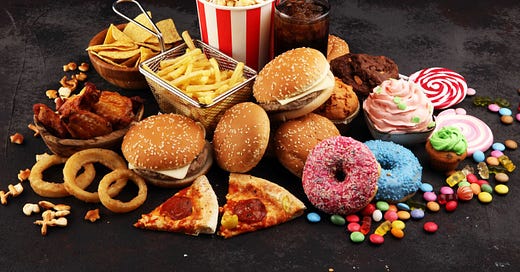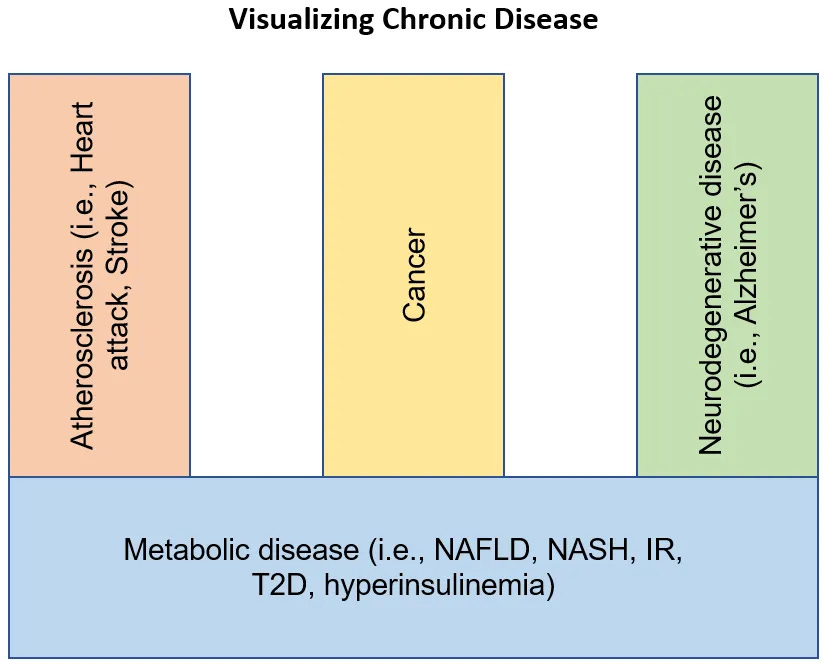The Standard American Diet
If you eat the SAD, you will probably die much sooner than if you don’t.
Housekeeping:
This is my first post with a guest appearance. If you want more, let me know!
Sunday posts are usually for paid subscribers but this edition is FREE for everyone. If you like what you read, please consider becoming a Member.
Córdoba, Argentina. November 2023.
I woke up, peeled off my sleeping mask, and welcomed the sun into my groggy eyes.
While waiting for the kettle to boil I did four sets of 25 push-ups, then sat down with my black AeroPress coffee and leather-bound journal to capture my messy morning thoughts on the page.
Morning routine complete, I laced up and strolled to the outdoor gym in a sprawling park twenty minutes from our Airbnb.
As I walked, I noticed men in hard hats huddled around the counters of a food truck parked on a tree-shaded avenue.
They were eating breakfast.
I watched.
Bright orange juice sat in plastic cups, sugar streamed into coffee, white toast spread with dulce de leche, crumbs of buttery pastries sprinkled on the aluminum countertop.
Lacking in my commitment to investigative journalism, I failed to duck behind parked cars and crouch behind trees to watch what they ate the rest of the day.
But I expect it was a whirlwind of fast food joints and convenience store pitstops.
Energy drinks and soda.
Burgers and fries.
Pre-prepared junk.
These construction workers are victims of the Standard American Diet, appropriately acronymed the SAD.
As Peter Attia points out in his book Outlive, the modern industrial food system solves four problems that have troubled us since we lived in caves:
How to produce enough food to feed almost everyone.
How to preserve food so it can be transported safely.
How to make it highly palatable.
How to do it inexpensively.
The SAD solves all four of these problems.
But in our haste, we forgot to include a fifth, critically important, criterion:
How to make it harmless.
The SAD is characterized by four harmful elements:
added sugar,
processed oils,
highly refined carbs with low fiber content,
and very calorically dense foods.
A lifetime of eating the SAD increases our risk for the Four Horsemen Diseases: Heart Disease, Cancer, Neurodegenerative Disease, and Metabolic Disease.
You and I will probably die from one of these diseases.
If we eat the SAD, we will probably die from one of them much sooner than if we don’t.
The SAD causes harm in many ways, but there is one pathway in particular worth understanding as it heavily influences our risk for each of these diseases: Metabolism.
Insulin resistance, a hallmark of poor metabolic health, is associated with massive increases in disease risk:
Cancer risk increases up to twelvefold.
Alzheimer’s disease risk increases fivefold.
Death from cardiovascular disease increases almost sixfold.
Think of metabolic disease — things like type 2 diabetes, insulin resistance, and non-alcoholic fatty liver disease — as the foundation of an early death.
Poor metabolic health probably won’t kill you directly, but it will expedite the onset of the other three horsemen (cancer, cardiovascular disease, and neurodegenerative disease).
Mitigating disease risk through metabolic health management starts with what and how much you eat and when you do it.
Anti-SAD Nutrition Strategies
Keto, carnivore, vegan, paleo, or whatever other diets people argue about on Twitter are all variations of three strategies.
Time restriction (TR): Restricting eating to certain times (ex. only eating between 12-8 pm every day).
Caloric restriction (CR): Eating less in total without consideration for what is being eaten or when it’s being eaten (ex. calorie counting on Cronometer).
Dietary restriction (DR): Eating less or none of some particular element(s) within the diet (ex. meat, sugar, carbs, fats).
To escape the SAD and ensure we stay far away from it, our daily approach to nutrition should deploy one or a combination of these strategies.
Time Restriction
Males
For almost all adult men, unless you’re concerned with sarcopenia (muscle wasting), I recommend time restricted eating (TRE).
Every man I know who’s gotten over the one to two-week adjustment period has found TRE to be an extremely effective strategy to prevent overeating and manage their weight.
For most people, TRE just means skipping breakfast and is an easy way to restrict total intake without needing to count your calories.
Females
My dear female readers, I did not forget about you!
I asked my friend and Chiropractic Doctor
, who writes deeply personal stories infused with expert knowledge at The Detour Is The Way, to provide guidance on TRE for women.Here’s what she wrote:
By design, women's brains and bodies are more sensitive to a drop in blood sugar. Prolonged fasting triggers a cascade of responses including an increase in stress hormone (cortisol) and a drop in reproductive hormones (estrogen and progesterone).
This can be a concern if you are trying to conceive, are undergoing tremendous stress, actively undergoing menopause, or have irregular/painful periods/PMS.
If you want to try TRE, be generous. Start with a 10 or 12 hour eating window on the first or second day of your period through a week or so after. But avoid the week right before your period as that is generally when the body is most vulnerable to stress.
(Thanks Maymie!)
If you’re worried about sarcopenia but still want to time restrict your eating, have a small protein-packed breakfast upon waking (could be a couple of eggs or a protein shake) then hold off eating your first full meal until lunch.
Caloric Restriction
TRE should help restrict your total intake at or slightly below your caloric maintenance.
If you choose not to deploy TRE, it’s up to you to find an effective strategy to ensure you don’t overeat on a consistent basis.
Excess energy consumption sustained over a long enough period of time results in a plethora of issues, starting with insulin resistance, weight gain, and increasingly poor metabolic health.
All issues that increase your risk of premature death.
Dietary Restriction
Dietary restriction is a social media hot topic with carnivores fighting vegans and vegetarians beefing with the keto clan.
These debates are a waste of time and energy.
In my experience, and following the wisdom of my great grandmother, the answer always comes back to moderation.
Everything in balance.
Humans are historically omnivorous and nearly all of us will feel and perform best when fuelled with a reasonable balance of carbs, protein, and fat.
Most of the time, try to avoid overly refined and processed foods, pre-packaged crap, added sugar, processed oils, very calorically dense foods, and highly refined carbs with low fiber content.
And, once in a while, go crazy and treat yourself to something you enjoy.
For me, that will be an entire gingerbread house covered in candy — shared with as few people as possible — during the holidays.
~~~
Related Reading
Questions, comments, feedback, complaints?
Hit reply to this email or leave a comment on the post. I would love to hear from you and I always reply!
Much love,
Jack







Jack - straight to the point! This is an information nutrient-dense piece, and without any of the jargon too. A great starter-guide for anyone thinking, "Now what?"
Also, I heard longevity scientist Valter Longo speak about his research on the "Fasting Mimicking Diet" - only 5 days, 4x/year for pretty astounding results. You might enjoy his book: https://www.valterlongo.com/the-longevity-diet/
Let me know if you check it out!
Jack + Maymie, love it! This is such a succinct, perfect breakdown. Will save and share widely.
The saddest thing about SAD is that it's now global, as your story tells. Also, thanks for the reminder I need to put journaling and push-ups back into my AM routine